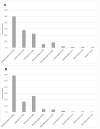Clinical Characteristics of Neurocysticercosis in a Peruvian Population-Based Epilepsy Cohort: A Descriptive Cross-Sectional Study of Baseline Clinical Intake
- PMID: 38003778
- PMCID: PMC10675766
- DOI: 10.3390/pathogens12111313
Clinical Characteristics of Neurocysticercosis in a Peruvian Population-Based Epilepsy Cohort: A Descriptive Cross-Sectional Study of Baseline Clinical Intake
Abstract
(1) Background: This study presents the baseline characteristics of a community-level population of people with epilepsy (n = 1975) living in an area endemic for Taenia solium, the pathogen responsible for neurocysticercosis (NCC). (2) Methods: Participants were sequentially enrolled in a clinical cohort from 2007 to 2020 in Tumbes, Peru. All participants provided demographic and clinical history and received clinical evaluations. Diagnostics, including neuroimaging, cysticercosis serologies, and EEG, were obtained where possible. The data presented are from the cross-sectional baseline assessment of cohort participants. (3) Results: Approximately 38% of participants met the criteria for NCC. Those with NCC were more likely to have adult-onset epilepsy, as well as a longer duration of epilepsy, as compared to their counterparts without NCC. Overall, the data indicate a large treatment gap, with only approximately a quarter of the baseline population with prescriptions for anti-seizure medications. (4) Conclusions: These data reveal a high proportion of NCC among people living with epilepsy in these communities, with limited health care resources. At baseline, 74% of the population were not receiving anti-seizure treatments. Further analyses of these data will clarify the natural history of the disease for this population.
Keywords: epidemiology; epilepsy; neurocysticercosis.
Conflict of interest statement
The authors declare no conflict of interest. The funders had no role in the design of the study; in the collection, analyses, or interpretation of data; in the writing of the manuscript; or in the decision to publish the results.
Figures


Similar articles
-
Accuracy of serological testing for the diagnosis of prevalent neurocysticercosis in outpatients with epilepsy, Eastern Cape Province, South Africa.PLoS Negl Trop Dis. 2009 Dec 8;3(12):e562. doi: 10.1371/journal.pntd.0000562. PLoS Negl Trop Dis. 2009. PMID: 19997629 Free PMC article.
-
Neurocysticercosis: association between seizures, serology, and brain CT in rural Peru.Neurology. 2005 Jul 26;65(2):229-33. doi: 10.1212/01.wnl.0000168828.83461.09. Neurology. 2005. PMID: 16043791
-
Epilepsy and neurocysticercosis: an incidence study in a Peruvian rural population.Neuroepidemiology. 2009;33(1):25-31. doi: 10.1159/000210019. Epub 2009 Mar 27. Neuroepidemiology. 2009. PMID: 19325247 Free PMC article.
-
Taenia solium Cysticercosis and Its Impact in Neurological Disease.Clin Microbiol Rev. 2020 May 27;33(3):e00085-19. doi: 10.1128/CMR.00085-19. Print 2020 Jun 17. Clin Microbiol Rev. 2020. PMID: 32461308 Free PMC article. Review.
-
From seizures to epilepsy and its substrates: neurocysticercosis.Epilepsia. 2013 May;54(5):783-92. doi: 10.1111/epi.12159. Epilepsia. 2013. PMID: 23621876 Review.
Cited by
-
The process of residual calcification following antiparasitic treatment in the pig model of neurocysticercosis is dynamic.PLoS Negl Trop Dis. 2025 May 5;19(5):e0013022. doi: 10.1371/journal.pntd.0013022. eCollection 2025 May. PLoS Negl Trop Dis. 2025. PMID: 40323912 Free PMC article.
-
Calcified Neurocysticercosis: Demographic, Clinical, and Radiological Characteristics of a Large Hospital-Based Patient Cohort.Pathogens. 2023 Dec 27;13(1):26. doi: 10.3390/pathogens13010026. Pathogens. 2023. PMID: 38251334 Free PMC article.
References
-
- Del Brutto O.H. Neurocysticercosis. Handb. Clin. Neurol. 2014;121:1445–1459. - PubMed
-
- White A.C. Neurocysticercosis: Updates on Epidemiology, Pathogenesis, Diagnosis, and Management. [(accessed on 11 November 2022)];Annu. Rev. Med. 2000 51:187–206. doi: 10.1146/annurev.med.51.1.187. Available online: www.annualreviews.org. - DOI - PubMed
-
- Moyano L.M., Saito M., Montano S.M., Gonzalvez G., Olaya S., Ayvar V., González I., Larrauri L., Tsang V.C.W., Llanos F., et al. Neurocysticercosis as a Cause of Epilepsy and Seizures in Two Community-Based Studies in a Cysticercosis-Endemic Region in Peru. PLoS Neglected Trop. Dis. 2014;8:e2692. doi: 10.1371/journal.pntd.0002692. - DOI - PMC - PubMed
Grants and funding
LinkOut - more resources
Full Text Sources
Miscellaneous

